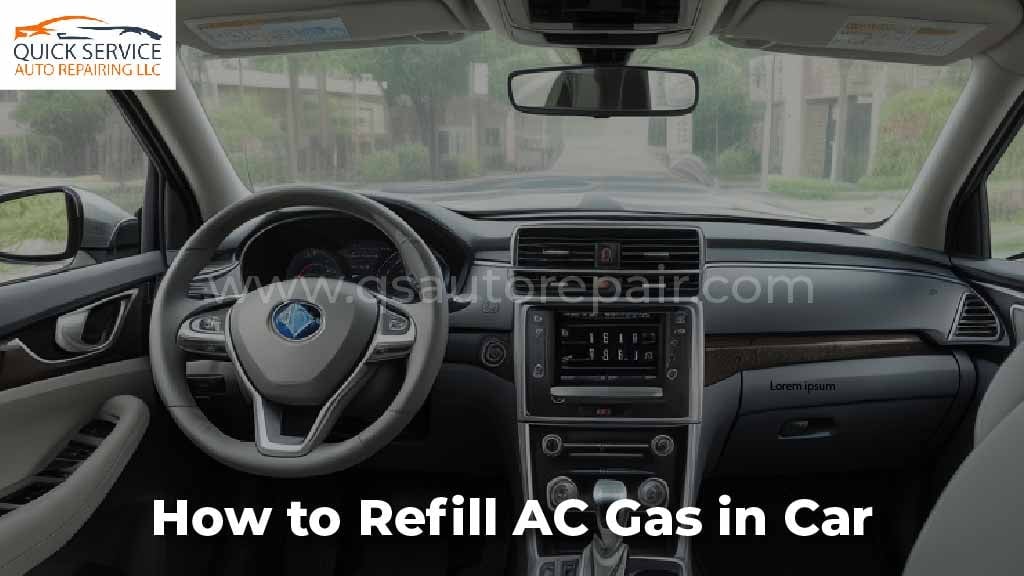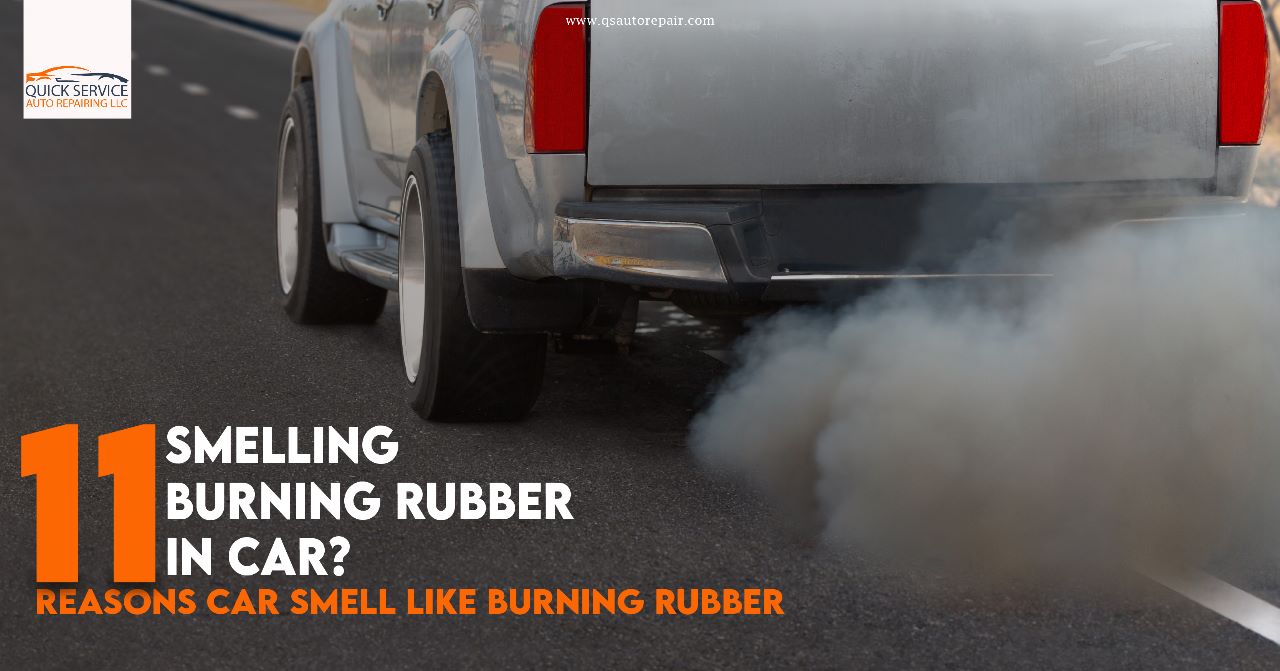نحن منفتحون 7 أيام في الأسبوع
Fri إلى خميس 08:00 صباحا - 10:00 مساءا
How to Refill AC Gas in Car: A Comprehensive Guide
Is the air conditioning system in your automobile not cooling your car as it should? If the air from your car’s vents is warm or less remarkable than usual, it might be time to refill the AC gas. Don’t worry; you don’t need to be an expert mechanic to perform this task. You can make your car’s AC blow cold air again on a hot day. Use the right tools, be safe, and learn How to Refill AC Gas in Car.

Why Is AC Gas Refilling Important?
Signs Your Car’s AC Needs Gas Refilling
Before diving into the process of refilling the AC gas, let’s identify some common signs that your car’s AC may be running low on refrigerant:
Reduced Cooling Efficiency:
When your car’s air conditioning works well, it cools your car fast and feels nice when it’s hot. But if it’s not so cold, your AC needs more gas. You might get warm air when you want it to be super cold, which can be annoying on a hot day. This happens when the AC doesn’t have enough unique stuff called refrigerant.
Slow Cooling:
A working AC system should blow cold air when you turn it on. If you wait for it to get cold, that’s a sign it needs more gas. Waiting can be annoying, especially when you’re hot. Fixing this quickly is essential to ensure your AC cools your car well.
Unusual Noises:
Pay attention to hissing or bubbling sounds when you activate your car’s AC. These unusual noises can indicate gas leakage or a low refrigerant level. The refrigerant should flow smoothly through the system without causing any sounds at the correct pressure. However, the refrigerant may move irregularly at low levels, leading to these audible indicators.
Warm Air from Vents:
The biggest clue that your car’s AC needs more gas is when the air from the vents isn’t as cool as it should be. This can be a real problem when it’s hot outside. Instead of nice cool air, it feels like the AC is just moving warm air around, and that’s not good for you and your passengers.
Knowing these signs is essential for caring for your car’s AC. If you notice any of these things happening, you should get it fixed fast. Ignoring these signs could lead to even more significant problems with your AC, costing you a lot of money. If you maintain regular maintenance and refill the gas when needed, your car’s AC will keep you comfy and happy on your drives, no matter the weather.
How to Refill AC Gas in Car
Preparing for AC Gas Refilling
Proper preparation is crucial for refilling your car’s AC gas. Here’s a detailed breakdown of the essential steps to ensure a successful and safe gas refill:
Gathering Necessary Tools
- AC Gas Refill Kit: The AC gas refill kit is the heart of the operation. It contains the refrigerant needed to recharge your AC system. It’s crucial to select the correct kit that is compatible with your car’s make and model. Always consult your owner’s manual or seek professional advice if unsure about the right kit for your vehicle. Your AC system could be harmed if the incorrect refrigerant is used.
- Safety Goggles and Gloves: Safety should be your top priority when working with refrigerants. Protect your eyes and skin by wearing safety goggles and gloves throughout the entire process. These safety measures guard against any potential contact with the refrigerant, which can harm your health.
- Owner’s Manual: Your car’s owner’s manual is invaluable during this process. It provides specific information about your vehicle, including the AC system’s requirements and safety precautions. Refer to your manual to ensure you follow the correct procedures for your car’s unique setup.
- Pressure Gauge: A pressure gauge is an essential tool for monitoring the pressure levels in your AC system. You’ll use it before, during, and after the gas refill to maintain the correct pressure.
- Wrench: Depending on your car’s AC system design, you may require a wrench to access and secure specific components. The wrench size can vary from one vehicle to another, so consult your owner’s manual for specific guidance.
- Rags or Paper Towels: It’s a good practice to have rags or paper towels on hand. These come in handy for cleaning up any spills or excess refrigerant and are helpful for general maintenance tasks.
Safety Precautions
Working with AC gas can be hazardous if not done with care. Adhering to safety precautions is crucial to protect yourself and the environment:
- Safety Goggles and Gloves: Always wear safety goggles and gloves when handling refrigerants. These safety measures shield your eyes and skin from potential exposure to the refrigerant, which can cause skin irritation and eye damage.
- Well-Ventilated Area: Perform the gas refill in a well-ventilated area. Proper ventilation is vital to prevent inhaling potentially harmful fumes released during the process. Avoid performing the refill in a confined space.
- Owner’s Manual Guidance: Your car’s owner’s manual contains specific safety precautions tailored to your vehicle. Read and follow these guidelines meticulously to prevent accidents and ensure the safe completion of the gas refill.
To get ready for a safe and effective AC gas refill, start by gathering the right tools and being careful about safety. Doing these first steps ensures your car’s AC works well so you can have a comfy and fun drive, even when it’s super hot outside.
Identifying the AC Low-Pressure Port
The low-pressure port is a crucial component in the AC gas refilling process. It’s the point where you connect the refill kit to add refrigerant to your car’s AC system. To find the low-pressure port, follow these steps:
Turn Off the Engine:
Begin by turning off your car’s engine and allowing it to cool down. Working on an excellent engine is essential to avoid potential risks or burns.
Locate the Low-Pressure Port:
The low-pressure port is typically on one of the two AC lines in your car’s air conditioning system. These lines are part of the AC system and are easily distinguishable, typically made of metal or rubber.
Identify the Larger Line:
To identify the low-pressure line, look for the larger two AC lines. The low-pressure port is usually situated on this line. It’s essential to distinguish between low-pressure and high-pressure lines, as connecting the refill kit to the wrong one can lead to problems.
Search for a Protective Cap:
A protective cap often covers the low-pressure port. This cap is designed to keep dust and debris from the port and protect it from damage. It may be labeled “L” or “Low” to indicate its purpose. However, not all vehicles have these labels, so the cap is the primary indicator.
Consult Your Owner’s Manual:
If you’re unsure where to find the low-pressure port, your car’s owner’s manual can help. It has pictures and explanations to show you where it is.
Use Proper Lighting:
Adequate lighting can search for the low-pressure port easier, mainly if it’s located in a tight or obscured area. A flashlight or work light can be invaluable for this purpose.
After you find the low-pressure port, you’re all set for the next gas-refilling steps. You’ll attach the AC gas refill kit hose to this port to put the refrigerant in your AC. Ensuring you have the right port is important for your AC to work well.
Connecting the AC Gas Refill Kit
- Begin by turning off your car’s engine and letting it cool down.
- Put on your safety goggles and gloves.
- Find the low-pressure port by opening the hood.
- Attach the hose of the AC gas refill kit to the low-pressure port. Ensure it’s secure.
Reading the Pressure Gauge
The pressure gauge is a vital tool during AC gas refilling. To read it:
- Connect the gauge to the low-pressure port.
- Check the pressure reading in PSI or bar.
- Compare it to the recommended level.
- If it’s below the recommendation, proceed with the refill.
- Avoid overfilling to maintain optimal cooling efficiency
Refilling the AC Gas
- Start the engine and turn the AC on to its maximum cooling setting.
- Open the AC gas refill kit valve to allow the refrigerant to flow into the system.
- Monitor the pressure gauge and stop refilling once it reaches the recommended level specified in your owner’s manual.
Checking for Leaks
After refilling the AC gas, inspect the AC connections using a soapy water solution. Please turn on the AC and watch for bubbles; they indicate leaks. Mark and address any leaks to maintain system efficiency and prevent refrigerant loss
Closing the System
Once you’ve confirmed no leaks and the pressure is at the correct level, close the valve on the refill kit.
Testing the AC
Turn off the engine and restart it to check if the AC is blowing cold air. If it’s cooling efficiently, your job is done. If not, you might need professional help to diagnose and fix any issues.
Additional Tips for Optimal Cooling
Regular Filter Maintenance:
Keep the AC filter clean or replace it regularly. A clogged filter restricts airflow, reducing cooling efficiency and compromising air quality. Check your owner’s manual for filter maintenance intervals.
Shade Parking:
Whenever possible, park your car in the shade. This reduces the initial temperature inside the vehicle, helping your AC system cool the interior more efficiently.
Avoid Maximum Settings:
While it may be tempting to blast the AC at its highest setting, it can strain the system and lead to overheating. Use the highest setting briefly, then adjust to a lower, comfortable level.
Following these additional tips ensures that your car’s AC system operates at its best, providing consistent and efficient cooling while helping extend the system’s lifespan.
Maintaining Your Car’s AC System
To ensure your car’s air conditioning system operates efficiently and provides consistent cooling, consider the following maintenance steps:
Regular Check-ups:
Schedule periodic inspections with a professional technician. They can assess the system for leaks, malfunctions, and overall performance.
Filter Maintenance:
Keep the AC filter clean or replace it as your owner’s manual recommends. Airflow and air quality are improved by a clean filter.
Leak Detection:
Watch for signs of refrigerant leaks, like reduced cooling efficiency or unusual noises. Address any problems right away to limit future harm.
Temperature Adjustment:
Avoid constantly running the AC on the highest setting. Gradually cool the interior to prevent overheating and excessive strain on the system.
Parking Smart:
Park in shaded areas to reduce the initial heat buildup inside the vehicle, making it easier for the AC to cool the interior.
Regular Servicing:
Follow your vehicle’s recommended maintenance schedule, often including AC system checks and servicing.
These steps allow you to maintain your car’s AC system in top condition, ensuring a comfortable and cool driving experience even during the hottest weather.
استنتاج
Refilling the AC gas in your car is a manageable task that can save you from sweltering in the heat. Following safety precautions and the step-by-step guide, you can keep your vehicle’s AC system running efficiently, ensuring you stay cool on your journeys.
FAQs
What kind of refrigerant should I use?
Always refer to your car’s owner’s manual to determine your vehicle’s correct refrigerant type.
How often should I refill AC gas?
The frequency of AC gas refilling varies depending on the vehicle and any potential leaks. It’s typically needed every 1-2 years.
Can I refill the AC gas on my own?
Yes, you can refill AC gas independently if you follow safety precautions and the guidelines in this article. However, if you are not confident, it’s advisable to seek professional assistance.
What should I do if I can’t find the low-pressure port?
If you can’t locate the low-pressure port, consult your car’s owner’s manual or seek assistance from a qualified technician.
Is it normal for my AC to lose gas over time?
It’s normal for AC systems to lose a small amount of gas over time. If the loss is significant, it may indicate a leak that needs repair. Regular maintenance can help identify and address such issues promptly.









